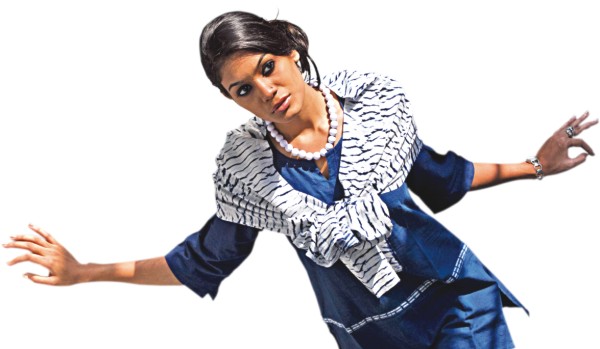COVER STORY

true blue
The tale of indigo in this region (northern Bangladesh and parts of West Bengal) dates back to ancient times. More than a millennium ago, the Arabs, Dutch and Greeks imported the plant for its rich, deep hue of blue. Those were times of relative prosperity, but the indigo plant in this region is also rooted in tales of death and oppression during British rule culminating in the Indigo Revolt of 1859-60, a stigma that still lingers. A century and a half later, it now seems that history has completed one of its cycles of irony, subverting the accepted truth; the indigo plant in twenty-first century Bangladesh stands to benefit the descendants of those it had once oppressed.
During the industrial revolution of Europe in the 18th century, demand for the natural dye grew exponentially. Indigo export from the colonies of European powers became a significant player in the race for supremacy. Around 1778, the East India Company began to ship the Bengal Indigo, known as true indigo, in huge quantities.
“200 years ago, indigo was a major product by which the British gained ascendancy over other European powers,” informed Arshad Siddiqui, technical coordinator of CARE Bangladesh, the not-for-profit organisation largely responsible for bringing indigo cultivation in Bangladesh to the fore. “It was the subject of a book co-authored by Pierre-Paul Darrac and Willem van Schendel in which tales of French spies coming to the region to learn the secrets of indigo cultivation have been documented.”

Darrac was commissioned by the French authorities to write a report on indigo in order to serve the interest of the French Government, which was planning to plant indigo in Senegal which was then a French colony.
The British, having hit gold with the locally cultivated indigo, drove the farmers hard to produce as much as possible while paying them a fraction of the price that indigo products fetched in Europe. Laws were passed to facilitate this. Millions died from the famine of 1859-60, which resulted from the collapse of food crops caused by the forced cultivation of indigo plants on paddy fields.
In 1870, within ten years of the revolt, remembered in Bengali history as the 'Nil Bidroho', synthetic indigo was invented, thereby sounding the death knell, or so it seemed, for the natural variety.
“But recently, because of growing discontent with the environmental ill-effects that synthetic dyes are causing, natural dyes have made a comeback, and none is more popular than indigo,” explained Siddiqui.
Although the rise of synthetic indigo put a halt to the production of the natural kind over much of the last 150 years, the cultivation of the plant itself has been ongoing in Bangladesh because of its intrinsic value. It is grown as a rotation crop that adds nitrates and yields valuable biomass on depleted land to replenish micro-nutrients for food cultivation.
But the techniques of extracting the rich blue colour from these plants had almost eroded through the passage of time. This is where CARE Bangladesh and their Social and Economic Transformation of the Ultra-Poor (SETU) project have contributed significantly.
“CARE Bangladesh provided the land for cultivation. It is a project designed for the ultra-poor -- those who live on two meals a day -- to see what capabilities they possess,” said Siddiqui. “A common skill of Bangladeshi women, especially those in rural areas, is stitching, and the organisation saw an opportunity there.”
And so, out of this combination of Bangladeshi women's natural penchant for stitching and the burgeoning global demand for natural indigo was born Nijera Cottage and Village Industries Pvt. Limited. The company is quite unique as far as development organisations in Bangladesh go, in that all the power rests in the hands of the locals; the board of directors who maintain executive control over the workings of the company is formed of local personnel.
| |
 |
The role of CARE Bangladesh has been that of facilitator and marketer, and they have performed their task admirably. In 2008, when Nijera was formed, CARE took their products -- mainly kanthas -- to the Nature Bazar in New Delhi, where they impressed international customers and there rose a demand for scarves, and things started rolling from there, with products from the company sold under the brand name Living Blue. All the profit from the sales of these products are distributed at the source, divided in payments dedicated to healthcare, education, welfare and cash -- usually fifteen to twenty percent of profits going to the producers of the items. Each product has a tag bearing the name and address of the craftsperson who made them so that the profits reach its proper destination.
“The natural dye campaign is going strong in Europe, especially in France and the UK, and also in Canada, Australia, Thailand and India, where there is huge demand for natural indigo,” Siddiqui related. “They form much of the clientele for products by Nijera. Recently there has been an offer from Conran UK.”
There is one downside though. Natural dyes are significantly more expensive than chemical dyes.
“If a chemical-dyed pair of jeans costs $100, a natural-dyed pair would cost $300 or $400,” informed Siddiqui. “But people who see the environmental benefit choose natural dyes.”
Other than export of the colour, a variety of products made by Nijera Cottage Industries make it out of the country to places like France, the UK, Australia and Canada and Thailand. These include bed quilts, cushions, floor mats, scarves, stoles, shawls and handbags.
The products are of very high quality, combining as they do the fine stitching skills of Bangladeshi women and the Japanese tie-dye technique of Shibori.
“The products are acclaimed all over the World Shibori Network, of which Nijera Cottage and Village Industries is a member,” said Siddiqui with not a small measure of pride.
But more needs to be done. According to Siddiqui, a fledgling company such as Nijera needs government support. The whole process can be more streamlined.
“For example, we cannot courier the products from Rangpur because of problems with infrastructure, and have to transport them ourselves. Also, even though we have international demand, to become really successful and independent the company has to establish a local stronghold. One way to do this would be to open an outlet in such an area of Dhaka, the diplomatic zone perhaps, where there will be demand for expensive but high-quality products.
“We also face problems when taking the products out of the country. This is where the Bangladesh government and organisations like the SME and the Bangladesh Bank can help.”
According to 'Nil Noboghone', a short documentary on the rebirth of indigo cultivation in Bangladesh, around 1200 families were directly or indirectly benefited by indigo as of 2010. It is a matter of great pride for all Bangladeshis that even under such crippling circumstances, we have the skill and natural resources to make our way out of the mire. It is up to us to ensure that endeavours like this do not go unrewarded, and are allowed to establish the stronghold Siddiqui talked about. Through Nijera Cottage and Village Industries and CARE-Bangladesh, history has offered us a chance to take the poisoned chalice that once was the indigo plant and transform it into a cup that bears the promise of economic health. It would be criminal to squander it.
By STS
Photo: Sazzad Ibne Sayed
Model: Isha
Wardrobe: Living Blue
To contact Living Blue, email at livingblue.nijera@gmail.com, or call 01911341152.
